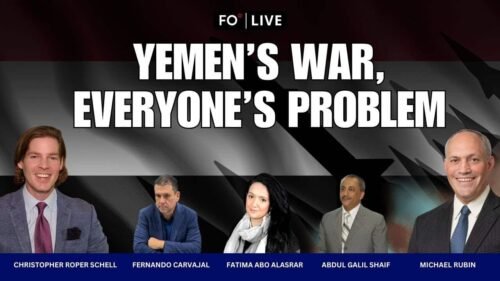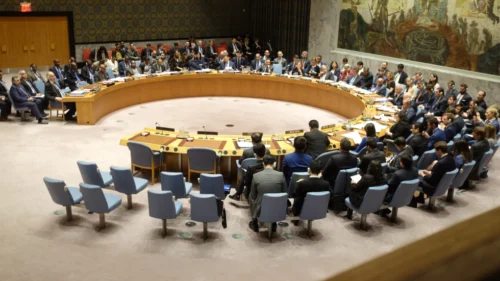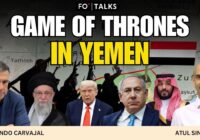The war in Yemen has dragged on for nearly a decade. Despite thousands of airstrikes, military operations, shifting alliances and failed international peace initiatives, the conflict remains unresolved. It is fragmented and dangerously misunderstood.
Most global attention focuses on headline events: missile launches in the Red Sea and Israel, drone attacks and the strategic calculus behind US and Israeli airstrikes. But to understand Yemen’s crisis and create a path out of it, the world must move beyond military tactics and grasp the deeper forces driving this dangerous conflict.
Limitations of military intervention in Yemen
Since the Arab coalition’s military intervention in 2015, and more recently with US-led strikes against the Houthis and Israeli attacks on civilian infrastructure, efforts to contain or weaken the Houthis by force have continued. These efforts have failed to produce the intended outcomes. The Houthis, supported by the Iranian regime, remain deeply entrenched, especially across northern Yemen, including the capital Sanaa. In many cases, they have strengthened their position by using these attacks to rally public support.
We must reaffirm what many analysts and officials ignore. The Houthis are a northern, Zaydi Shiite movement. Their power lies in the North, not the South. They have imposed themselves on the northern population by force. They believe they have a divine right to rule the country.
Military strikes may disrupt attacks on shipping lanes, but this only prolongs the conflict. Military intervention does not address the reasons behind the Houthis’s rise or the political and social conditions that sustain their rule. The world cannot resolve Yemen’s war from 30,000 feet above. It needs political engagement and a faster peace process with real goals and intentions.
These actions embolden the Houthis, encourage broader armed mobilization and shrink the already limited space for diplomacy. They help the Houthis reinforce their claim as a resistance force fighting foreign intervention. This claim has helped them gain sympathy both locally and internationally. Some argue that the bombing campaign has allowed them to present themselves as victims rather than aggressors.
What is the alternative?
The international community must change its strategy. Targeted pressure through sanctions and limited military measures can play a role, but pressure without a political roadmap will fail. It will not bring the Houthis to the negotiating table. It will push them into isolation.
Foreign powers need a political formula that weakens the Houthis enough to make negotiation possible and recognizes Yemen’s new realities. This war is no longer a two-sided conflict. It has multiple centers of power. Each center has its own legitimacy, audience and military strength.
One of the most important and often neglected of these centers is the Southern Transitional Council (STC) — an independent movement in southern Yemen. After the Houthis invaded the South in 2015, the STC could have chosen a path like the Houthis. Instead, they worked with the regional and international community to pursue a peaceful resolution. Many of their supporters now question whether that was the right choice.
The STC is not a marginal player. It represents the hopes of millions in the South who seek independence or autonomy. The STC has military power and enjoys popular legitimacy in many southern areas. It also helped to defeat the Houthis’s 2015 push into the South. In doing so, it succeeded where others with international recognition and regional backing failed.
Given the significance of the STC in Southern politics, excluding it from future peace talks fosters instability. Ignoring the South in a peace agreement risks triggering another war between the North and South. This is not a theory, but rather a threat rooted in history and current tensions.
Any lasting settlement must include the STC as an equal partner with the Houthis, the recognized government and regional players. Fairness alone isn’t enough; strategic necessity demands it. Without the South, Yemen’s peace will be partial, fragile and short-lived.
The international community must consider alternatives to the old model of centralized unity. A two-state solution should be an option. At the very least, Yemen needs a deeply decentralized federal system, as the current structure is broken. Forcing unity through a centralized government that lacks legitimacy in much of the country is not realistic.
A broader vision for peace
The US must lead these peace dealings. Washington has the leverage to influence local and regional players, especially Saudi Arabia and the United Arab Emirates, and push them toward an inclusive and realistic political roadmap. They must stop relying on military force and support a diplomatic strategy that aims for long-term stability. The centralized unity project has failed. Recognizing realities on the ground will not weaken peace. It will make peace possible. This shift will serve American and international interests. It will help secure Red Sea shipping lanes, reduce Iranian influence and restore US credibility as a force for peace.
As the US repositions its role, the UN must also reassess its performance. Its mediation efforts have not produced major results. To be a real mediator, the UN must speed up negotiations, apply diplomatic pressure and expand the peace effort to include all major parties. The current peace effort and its supporting resolutions are outdated. They do not reflect the actual distribution of power in Yemen. Without changes, they will not produce real results.
Western governments, especially the US and European allies, must coordinate closely. Supporting Yemen’s future requires more than a truce, humanitarian aid or prisoner swaps. It means rebuilding institutions, creating systems for fair resource sharing and supporting dialogue among all political forces, especially those tied to external actors. It also means working with Saudi Arabia and the United Arab Emirates, which still hold significant influence over Yemen’s political and military affairs.
Airstrikes will not end Yemen’s crisis, nor will excluding uncomfortable actors. Yemen will reach peace through serious diplomacy, smart pressure and honest recognition of who holds power on the ground.
The US and the UN must apply enough pressure to bring the Houthis to the table. But they must also make sure the table includes all key parties, especially the Houthis and the STC. Without this balance, they will not create peace. They will only delay the next war.
[Kaitlyn Diana edited this piece.]
The views expressed in this article are the author’s own and do not necessarily reflect Fair Observer’s editorial policy.
Support Fair Observer
We rely on your support for our independence, diversity and quality.
For more than 10 years, Fair Observer has been free, fair and independent. No billionaire owns us, no advertisers control us. We are a reader-supported nonprofit. Unlike many other publications, we keep our content free for readers regardless of where they live or whether they can afford to pay. We have no paywalls and no ads.
In the post-truth era of fake news, echo chambers and filter bubbles, we publish a plurality of perspectives from around the world. Anyone can publish with us, but everyone goes through a rigorous editorial process. So, you get fact-checked, well-reasoned content instead of noise.
We publish 3,000+ voices from 90+ countries. We also conduct education and training programs
on subjects ranging from digital media and journalism to writing and critical thinking. This
doesn’t come cheap. Servers, editors, trainers and web developers cost
money.
Please consider supporting us on a regular basis as a recurring donor or a
sustaining member.
Will you support FO’s journalism?
We rely on your support for our independence, diversity and quality.











Comment